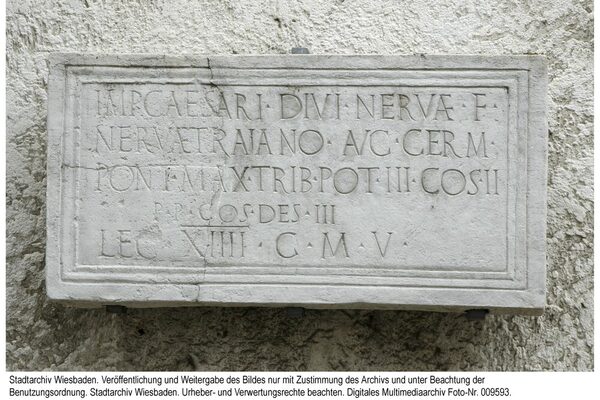Arch of Honor Mainz-Kastel
In 1986, the foundations of an arch of honor were uncovered during excavation work at Große Kirchenstraße 5-13 in Mainz-Kastel. The monument, erected on a gravel bank on the flood-free bank of the Rhine, occupied a very prominent position: erected directly in front of the northern side gate ("porta principalis sinistra") of the Flavian stone fort, it spanned the road coming from Hofheim and continuing over the Rhine bridge to the legionary camp on the Kästrich, where a route with milestones branched off to Wiesbaden. Today it can be viewed in a museum room. Based on comparisons with similar monuments from Rome and Orange, an arch of honor with a central passageway about 8 m wide flanked by two narrower and lower passages has been reconstructed. Only a few remains were found of the rising masonry of the approximately 13 m high arch. Although it was possible to secure the street ceiling of the central passageway, which had been renewed several times using smaller pieces of stone material in a cement bed, the entire building ornamentation and the reliefs decorating the arch had been smashed into tiny pieces.
One of the few surviving pieces is a 1.04 m high fragment of a frieze panel depicting a rural scene above an acanthus vine. Other fragments bear depictions of larger-than-life river gods or smaller human figures. Only a larger-than-life hand was found from a crowning equestrian statue made of bronze. The dating of the arch is still the subject of controversy today. According to the stonemason's markings 'L XIII', the monument was certainly executed by the 14th legion stationed in Mainz in 13 BC-43 AD and again in 70/72-101 AD. It is therefore either regarded as the remains of the arch that was erected on the banks of the Rhine ("apud ripam Rheni") by decree of the Senate for the early deceased general Germanicus, son of Drusus, although it remains unclear whether the monument stood to the right or left of the river. Due to the topography, it can just as easily be linked to the occupation of the so-called Decumatland ("decumates agri") under the Flavians, which included the areas on the other side of the Rhine and Danube and thus also the Wetterau.
Literature
Reallexikon der Germanischen Altertumskunde, 2nd ed., vol. 20, Berlin, New York, 2002, p. 147, § 1 (J. Oldenstein, Mogontiacum, with further references).
